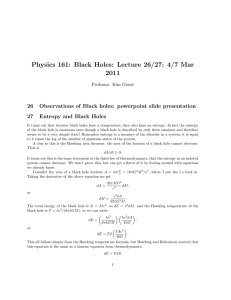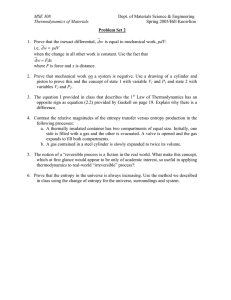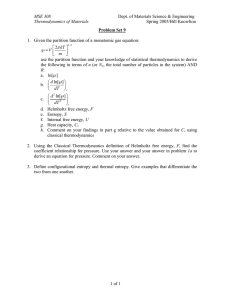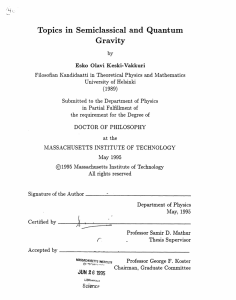Physics 161: Black Holes: Lecture 26/27: 5/8 Mar 2010 26
advertisement
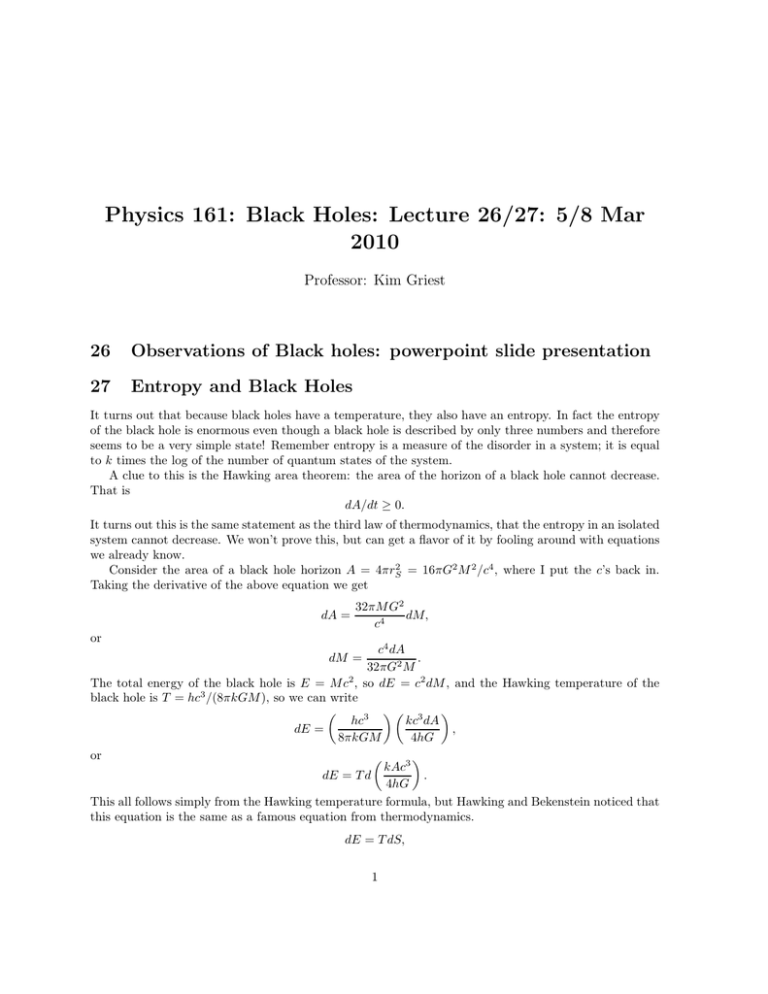
Physics 161: Black Holes: Lecture 26/27: 5/8 Mar 2010 Professor: Kim Griest 26 Observations of Black holes: powerpoint slide presentation 27 Entropy and Black Holes It turns out that because black holes have a temperature, they also have an entropy. In fact the entropy of the black hole is enormous even though a black hole is described by only three numbers and therefore seems to be a very simple state! Remember entropy is a measure of the disorder in a system; it is equal to k times the log of the number of quantum states of the system. A clue to this is the Hawking area theorem: the area of the horizon of a black hole cannot decrease. That is dA/dt ≥ 0. It turns out this is the same statement as the third law of thermodynamics, that the entropy in an isolated system cannot decrease. We won’t prove this, but can get a flavor of it by fooling around with equations we already know. Consider the area of a black hole horizon A = 4πrS2 = 16πG2 M 2 /c4 , where I put the c’s back in. Taking the derivative of the above equation we get dA = 32πM G2 dM, c4 or c4 dA . 32πG2 M The total energy of the black hole is E = M c2 , so dE = c2 dM , and the Hawking temperature of the black hole is T = hc3 /(8πkGM ), so we can write 3 kc dA hc3 , dE = 8πkGM 4hG or kAc3 . dE = T d 4hG This all follows simply from the Hawking temperature formula, but Hawking and Bekenstein noticed that this equation is the same as a famous equation from thermodynamics. dM = dE = T dS, 1 where S is the thermodynamic entropy of the system. Thus they identified the entropy of the black hole as A kc3 S= . 4 hG Thus in this identification the entropy is proportional to the surface area of the black hole. What is totally cool about this identification, is the Hawking area theorem that says the area of a black hole can never decrease becomes the third law of thermodynamics which says that the entropy of a system can never decrease. This thermodynamic identification also implies that black holes should radiate as blackbodies, which they do. In fact, the surface area of a black hole does decrease as it radiates, but then one needs to take into account the entropy of the radiation. Overall the entropy of the entire system, black hole plus Hawking radiation does not decrease. The thermodynamics works out great. It is a beautiful connection that Hawking and Bekenstein and others made, and fits together perfectly. String theorists recently had one of their few successes, when they managed to calculate the entropy of a black hole using string theory and got the Hawking/Bekenstein answer. It was a post-diction not a prediction, but it gave great encouragement to the string theory community and lead to several new and deep understandings of the relation between black holes and thermodynamics, including information loss in black holes. The string theorists were able to count the quantum states of a black hole by finding a dual system, that is, a set of equations that described a black hole but using a specific quantum field theory rather than general relativity. The black hole was dual to a gas of hot gluon-like particles, in which the quantum states could be counted. It came out to be just the Hawking/Bekenstein answer. The spectrum of radiation coming from the gas of hot gluons could also be counted using the QFT and it was Hawking answer. One should note that this calculation was not for a normal spherical black hole, but for a certainly limiting case of a very particular model that does not exist in the real world, that is a maximally charged black hole with 4 supersymmetries), but still this was a great success for string theory and helps greatly in our understanding of what black holes really are. Finally, there are interesting new developments that are very related to these issues. They go by the name “holographic” principle in string theory. The basic puzzle is why the entropy of a black hole is proportional to its surface area. Normally we think of entropy as an extensive quantity; if you double the volume of a box of gas, you double the entropy of that system. Here however, the entropy does not go as the volume. This is weird since you really think that the number of quantum states that a system has should depend upon its volume size, not the area of the bounding surface. The holographic idea is to generalize this principle to all systems: the number of degrees of freedom of any system should be limited by a bounding surface area, and scale as surface area, not volume. For a black hole it might make some kind of sense, since we saw everything kind of gets hung up at the horizon and never makes it in (as observed from far away). But why would this be true in general? There are several deep string theory reasons for these speculations and they are the topics of current research. 2



